The one perennial truth – rich or not, successful or not, religious, philosophical, it doesn’t matter – you will die. From the beginning of time to the end, death is the one universal inescapable commonality. Kings or peasants, brilliant or stupid, everyone dies or is dead. Some try not to think about it. But for others, the certainty of death is kept at the forefront of thought. Why? So that they might really live.
“ Memento Mori ,” or translated in English, “Remember you must die.” The point of this reminder isn’t to be morbid or promote fear, but to inspire, motivate and clarify. The idea has been central to art, philosophy, literature, architecture, and more throughout history. As Socrates says in Plato’s Phaedo , “The one aim of those who practice philosophy in the proper manner is to practice for dying and death.”
In this article, we’ll explore the history of this seemingly haunting, but actually inspiring, phrase as well as where it came from and what it means. We’ll show you how it has evolved through its many forms of practice and interpretation in literature, art, fashion, and present day popular culture — where thousands of people carry Memento Mori coins in their pockets or have adapted other physical reminders to keep the thought of death with them at all times.
A TIMELESS CULTURAL PRACTICE
STOICS
Seneca urged in his Moral Letters to Lucilius , “ Let us prepare our minds as if we’d come to the very end of life. Let us postpone nothing. Let us balance life’s books each day…The one who puts the finishing touches on their life each day is never short of time. ”
In Meditations , Marcus Aurelius wrote to himself: “ You could leave life right now. Let that determine what you do and say and think. ” The emperor considered it imperative to keep death at the forefront of his thoughts. In doing so, the world’s most powerful man managed the obligations of his position guided by living virtuously NOW.
Epictetus would ask his students, “ Do you then ponder how the supreme of human evils, the surest mark of the base and cowardly, is not death, but the fear of death? ” And begged them to “ discipline yourself against such fear, direct all your thinking, exercises, and reading this way — and you will know the only path to human freedom. ”
The Stoics used Memento Mori to invigorate life, and to create priority and meaning. They treated each day as a gift, and reminded themselves constantly to not waste any time in the day on the trivial and vain.
ROMANS
Memento Mori is believed to have originated from an ancient Roman tradition.

After a major military victory, the triumphant military generals were paraded through the streets to the roars of the masses. The ceremonial procession could span the course of a day with the military leader riding in a chariot drawn by four horses. There was not a more coveted honor. The general was idolized, viewed as divine by his troops and the public alike. But riding in the same chariot, standing just behind the worshipped general, was a slave. The slave’s sole responsibility for the entirety of the procession was to whisper in the general’s ear continuously, “Respice post te. Hominem te esse memento. Memento mori!”
“Look behind. Remember thou art mortal. Remember you must die!”
The slave served to remind the victor at the peak of glory, this god-like adoration would soon end, while the truth of his mortality remained.
EGYPTIANS
Of the seven ancient wonders of the world, only one remains intact – the Great Pyramid of Giza. How the ancient Egyptians transported over 170,000 tons of limestone to erect the pyramid continues to puzzle archaeologists, but the why is better known.
Preceding the pointed smooth-sided pyramids were bench-shaped mounds called mastabas, built atop the tombs of early kings and pharaohs. The Great Pyramid displays an advancement aesthetically, but not symbolically. An estimated 20,000 civilians contributed to the 20 year construction of the pharaoh Khufu’s burial chamber – a structure memorializing the fate shared by the royals and the common.
Excavated mummies, tombs, and pyramids reveal that remembering death was entrenched in ancient Egyptian culture. Egyptologists maintain the preservation of dead bodies and the building of elaborate death chambers were an act of celebrating life, and a reverence for its ephemeralness.
Michel de Montaigne, known for creating the essay as a literary genre and regarded as the Father of Modern Skepticism, wrote in an essay titled That to Study Philosophy is to Learn to Die of the ancient Egyptian custom where celebratory feasts concluded with the raising of a skeleton to the chant, “Drink and be merry, for such shalt thou be when thou are dead.”
In the height of celebration, Egyptian custom was to set remembrance to the frailness and fleetingness of festival. Through the visual of the skeleton and the pronouncing of the chant, celebrators reeled in the jollity to acknowledge the moment would soon pass so not to take it for granted.
BUDDHISTS
Mindfulness of death is a central teaching in Buddhism. The meditative practice maranasati, meaning “death awareness,” is considered essential to better living. It brings recognition to the transitory nature of one’s physical life, and stimulates the question of whether or not one is making the right use of their fragile and precious life.
As Buddha put it, “Of all the footprints, that of the elephant is supreme. Similarly, of all mindfulness meditation, that on death is supreme.”
CATHOLICS
The Bible is the most read book in the world . The most read book of the most read book is the book of Psalms from the Old Testament. It is also the longest book of the Bible, and the most quoted book in the New Testament. Theologists attribute its reverence to capturing human emotion, not just in the joys of life, but in the struggles as well. C.S. Lewis, devout Christian and one of the 20th century’s most influential writers, wrote Reflections on the Psalms because the Psalms were an aid in the “difficulties I have met” and the “lights I have gained.”
Lewis devotes a chapter to the transitory nature of life. Death in the Psalms centers around immortality and that “death is inevitable.” He references Sheol, “the land of the dead,” Hades, god of the underworld, and Plato’s “vivid and positive doctrine of immortality,” before citing Psalm 89:46 as the “clearest of all” reflections, “ O Remember how short my time is .”
The fall of the Roman empire in the fifth century lead to a tumultuous period of conflict, plague, and political crisis. Without a strong central government to maintain order, the Catholic Church surged as the most powerful institution. Kings, queens, and other leaders derived power through their allegiance to and protection of the Church. Devotion was proven by the building of grand cathedrals, churches, and other ecclesiastical monuments. Funerary art displayed to compel visitors to reflect on the gift of life. Crucifixes and tombs were most common. Remembering the inevitability of death is a core Biblical theme. It remains prevalent today far beyond the written word.
A REMINDER THROUGH ART
DANSE MACABRE
The Late Middle Ages was a period of devastation. A catastrophic plague, the Black Death, devastated Europe, killing an estimated 25 million people – one-third of the population. Out of the grim horrors and fight for survival grew an art genre called Danse Macabre, meaning Dance or Death . Like plague, Danse Macabre illustrates the all-conquering power of death. Paintings include kings with peasants, young with old, to convey that death comes for everyone.
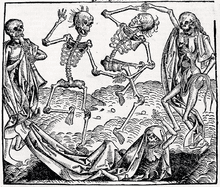
The Dance of Death by Michael Wolgemut
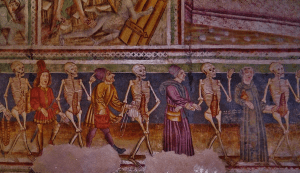
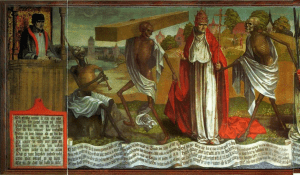

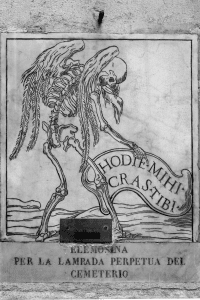
VANITAS
Life is fleeting so best to not waste it on meaningless goods and pleasures. That’s the message behind vanitas art. Inspired by the first chapter of Ecclesiastes (“ vanity of vanity, all is vanity ”), Dutch Golden Age artists of the 17th century used still-life as moral instruction. Artists emphasized the emptiness and futility of earthly items. Skulls, candles, hourglasses, watches, rotting fruit, wilting flowers, and fraying books sat atop a table to remind viewers just how precious life is.
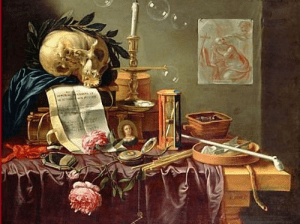
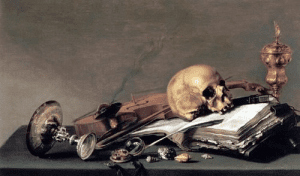


MOURNING RINGS
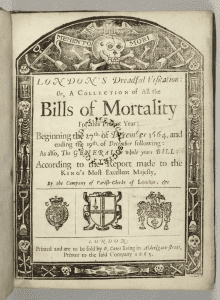
The haunting reality of life’s uncertainty showed itself in many forms: art, literature, architecture, and a new trend, jewelry. Memento Mori rings were worn by everyone from Queen Victoria to the impoverished. Skeletal bands and skulls wearing a crown reminded wearers that death is the master of all.




Check out Daily Stoic’s recent memento mori ring. Handcrafted in California.
A MODERN RESURGENCE
While Memento Mori has fallen from consciousness compared to its historical relevance, mortality motivation is practiced modernly in fueling successful entrepreneurs, artists, athletes, authors, among others.
Steve Jobs famously said:
“Remembering that I’ll be dead soon is the most important tool I’ve ever encountered to help me make the big choices in life. Almost everything — all external expectations, all pride, all fear of embarrassment or failure — these things just fall away in the face of death, leaving only what is truly important. Remembering that you are going to die is the best way I know to avoid the trap of thinking you have something to lose. You are already naked. There is no reason not to follow your heart.”
Writer and media strategist Ryan Holiday carries around a Memento Mori medallion to remind him of his mortality.
Click here to learn more about the memento mori medallion.
You can join Holiday, Tim Ferriss , Casey Neistat , Gary Vaynerchuk , and many more by getting the same coin here . As Holiday says:
“It’s easy to lose track of that mortality, to forget time, to think that you’re going to live forever. The idea that you’re gonna die and that life is short is only depressing if you’re thinking about it wrong. If you’re thinking about it right it should give you a sense of priority. It should even give you a sense of meaning; it should let you know what’s important, what you’re trying to do while you’re here on this planet.”
Billionaire author, entrepreneur, philanthropist, and life coach Tony Robbins has said:
“There’s something coming for all of us. It’s called death. Rather than fearing it, it can become one of our greatest counselors. So, if this was the last week of your life, what would you cherish most? How would you live? How would you love? What truth would you tell today?”
When entrepreneur, author and speaker Gary Vaynerchuk was asked to give three words of inspiration to someone, he said, “ You’re gonna die .” Gary explains this later by saying:
“The reason I believe in it(death as motivation) is because it’s ultimately practical. It’s the guiding light and the fire and ambition that drives me toward legacy and living my best life.”
Tim Ferriss ,best selling author, entrepreneur, and host of one of iTunes most listened to Podcasts, shared an image on Instagram of his Memento Mori coin, with a caption explaining how he reminds himself to not take any day for granted:
“I’m enjoying having this Memento Mori (remember you will die) coin in my pocket as a reminder: there is wonder all around us, but we are ephemeral. I’m trying to note and enjoy the small things that expire quickly.”
In 2007 Damien Hirst created one of the more famous modern art examples of Memento Mori with his
For The Love of God
, featuring over 8,000 diamonds laid out on a human skull. The piece sold for a reported £50 million.

In 2014, Disney added a store called Memento Mori to their Magic Kingdom Park. The store features “ haunted mansion themed merchandise .”

The world-renowned fashion brand, Gucci, recently used Memento Mori as a theme in their Gucci Cruise 19 show. The show was held in a graveyard in Arles, France.

The multi-platinum and three time Grammy winning R&B singer The Weeknd, titled his 2018 radio show “ Memento Mori ,” featuring his favorite music that is inspired by late nights.

And Mac Miller , whose promising music career ended prematurely, let us with the reminder. Just 8 weeks before his tragic passing, he shot his final music video which included a scene of him carving the words M emento Mori in a coffin. The screenshot below captures the moment before Mac punches through the coffin. The scene progresses to Mac freeing himself from the coffin, climbing atop a pile of dirt, to the verse:
I got all the time in the world
So for now, I’m just chillin’
Plus, I know it’s a, it’s a beautiful feeling
In oblivion
Talk about art getting real.

Today, the typical person doesn’t think about death at all because it’s uncomfortable, sad or scary. Fortunately, we’re no longer cavemen afraid that we’re going to be eaten by a lion, or ancient Romans afraid we’ll be murdered by a gladiator, or Medieval sires afraid we’ll fall victim to plague. Unfortunately, however, as the world has gotten safer and better, we start to think that we’re going to live forever and that things are always going to go exactly our way. The Stoics would say that death is what gives life meaning – it’s the cap at the end that helps us make the most of the time we’ve been given.
Dr. BJ Miller, a hospice and palliative care physician, and a triple amputee survivor of a near-death electrocution accident, says meditating on death has become taboo in our culture but is the secret to living:
“For those of us who work in the field of hospice and palliative care, it can feel like you’re sitting on a secret…Sure it is loaded, emotionally laden work…But, you pretty quickly get a real sweet hit that paying attention to this zone of life is very nurturing. The secret is that paying attention to the fact that you die can help you live a lot better. My colleagues and I are very aware of the clock. We’re aware of our finitude and so, we’re just a little more likely to be kind to ourselves and others, and we’re a little less likely to squander that time. ”
The truth is, we have all been given a fatal diagnosis. The doctor who pulled you out of your mother knew for certain that you were going to die, he just didn’t know exactly when. And neither do you. So keep the reminder of Memento Mori with you. Don’t waste your time on trivial, pointless things. Don’t take for granted the time you have.
To keep this powerful reminder in mind, explore some of Daily Stoic’s memento mori themed items below:

